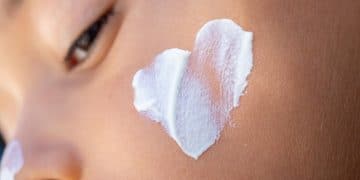The Best Skincare Routine for Dry Skin: A Comprehensive Guide for 2025

Anúncios
Achieving optimal skin health for dry complexions involves a meticulous, multi-step regimen focused on intense hydration, barrier repair, and gentle care, utilizing specific ingredients and techniques to alleviate dryness and enhance skin comfort and appearance.
Navigating the world of skincare can be daunting, especially when dealing with the unique challenges of dry skin. From flakiness and tightness to a dull complexion, identifying and implementing The Best Skincare Routine for Dry Skin: A Comprehensive Guide is crucial for achieving lasting comfort and a vibrant glow. This guide delves into the essential steps and product choices that can transform your dry skin, ensuring it feels supple, hydrated, and truly healthy.
Understanding Dry Skin: Causes and Characteristics
Dry skin, scientifically known as xerosis, is a common condition characterized by a lack of moisture in the outermost layer of the skin, the stratum corneum. This deficiency results in an impaired skin barrier, leading to increased transepidermal water loss (TEWL) and a host of uncomfortable symptoms. Understanding the root causes and unique characteristics of dry skin is the first step towards an effective skincare strategy.
Common Causes of Dry Skin
Various factors can contribute to skin dryness, both internal and external. Environmental elements play a significant role, particularly in regions with low humidity. Cold weather, strong winds, and excessive sun exposure can strip the skin of its natural oils and moisture. Even indoor environments, heated with forced air, can significantly reduce the air’s humidity, pulling moisture from the skin.
- Environmental Factors: Low humidity, cold weather, wind exposure, excessive sun.
- Genetics: Predisposition to conditions like eczema or ichthyosis.
- Aging: Decreased natural oil production as we age.
- Harsh Products: Soaps and cleansers with strong detergents or alcohol.
Key Characteristics to Identify
Recognizing the signs of dry skin is essential for tailoring your routine. Beyond the obvious sensation of tightness, dry skin often appears dull, rough, or can even feel scaly. Fine lines and wrinkles may be more pronounced, as dehydrated skin tends to exaggerate their appearance. In severe cases, dry skin can crack or become inflamed, leading to discomfort and increased sensitivity.
The texture of dry skin often feels rough to the touch, lacking the smooth, supple feel of well-hydrated skin. Pores may appear smaller or less visible compared to other skin types, as there is less oil production. It is important to distinguish dry skin from dehydrated skin, though the symptoms can overlap. Dry skin refers to a lack of oil (lipids), while dehydrated skin refers to a lack of water. Many individuals experience both, compounding the challenge.
Understanding these fundamental aspects of dry skin empowers individuals to make informed decisions about their skincare, moving beyond generic recommendations to a personalized approach that genuinely addresses their skin’s needs. This foundational knowledge sets the stage for building the ultimate skincare routine for dry skin, focusing on hydration, barrier repair, and nourishing ingredients.
The Foundational Pillars of Dry Skincare
Building an effective skincare routine for dry skin isn’t just about applying a few random products; it’s about establishing foundational practices that support and repair the skin’s natural barrier. This holistic approach ensures long-term hydration and health, addressing the core issues rather than just the symptoms of dryness. The three main pillars are gentle cleansing, targeted hydration, and robust barrier protection.
Gentle Cleansing: The First Step
For dry skin, cleansing is a delicate act. The goal is to remove impurities and makeup without stripping the skin of its essential natural oils. Harsh cleansers, particularly those containing sulfates or strong foaming agents, can aggravate dryness by disrupting the skin’s lipid barrier. Opt for creamy, non-foaming cleansers that are pH-balanced and designed for dry or sensitive skin. Look for ingredients like glycerin, hyaluronic acid, and ceramides that help retain moisture during the cleansing process. Avoid hot water, as it can be very dehydrating; lukewarm water is always the best choice.
Massage the cleanser gently onto damp skin in circular motions, then rinse thoroughly. Pat your face dry with a soft towel, avoiding any harsh rubbing that can irritate compromised skin. The immediate feeling after cleansing should be soft and comfortable, not tight or stretched. This initial step sets the stage for the rest of your routine, ensuring your skin is clean but not compromised.
Targeted Hydration: Replenishing Moisture
Hydration is the cornerstone of any dry skin routine. This goes beyond just a basic moisturizer; it involves layering products that provide different forms of moisture and humectants. Serums rich in hyaluronic acid, glycerin, and polyglutamic acid are excellent for drawing moisture from the air and deeper layers of the skin into the epidermis. These “water-magnets” plump the skin, reducing the appearance of fine lines and creating a smoother canvas.
Apply hydrating serums immediately after cleansing, while the skin is still slightly damp, to maximize absorption. Follow with a rich emollient moisturizer that contains occlusive ingredients like petrolatum, shea butter, or squalane. These ingredients create a protective layer on the skin’s surface, preventing transepidermal water loss. The combination of humectants and emollients ensures both deep hydration and effective moisture retention, addressing the two primary hydration needs of dry skin.

Barrier Protection: Fortifying Your Skin
The skin barrier acts as your body’s first line of defense against environmental aggressors and moisture loss. For dry skin, this barrier is often compromised, necessitating products that actively work to repair and strengthen it. Ceramides are lipids naturally found in the skin barrier, and topical application can replenish depleted levels, improving the skin’s ability to retain moisture and defend itself.
- Ceramides: Essential lipids that help restore the skin’s natural barrier.
- Niacinamide: Boosts ceramide production and reduces inflammation.
- Fatty Acids: Support overall skin health and integrity.
- Antioxidants: Protect the barrier from environmental damage.
Incorporating a ceramide-rich cream or serum into your routine can make a dramatic difference. Additionally, ingredients like niacinamide not only strengthen the barrier but also offer anti-inflammatory benefits, which can be particularly helpful for sensitive dry skin. Using a broad-spectrum sunscreen daily is also a non-negotiable step for barrier protection, safeguarding the skin from UV damage, which can further compromise its health and accelerate moisture loss. By focusing on these pillars, you create a robust and resilient skin environment that truly thrives.
Morning Routine for Dry Skin: A Hydration Boost
The morning routine for dry skin is all about protecting your skin from environmental aggressors while locking in hydration for the day ahead. It’s a proactive approach to ensure your skin stays comfortable, supple, and radiant from dawn till dusk. Each step is carefully chosen to support the skin’s barrier and provide a continuous supply of moisture.
Gentle Cleanse & Prep
Start your day with a very gentle cleanse. For dry skin, some experts even suggest skipping a full cleanse in the morning and simply rinsing your face with lukewarm water. If you prefer a cleanse, opt for a creamy, non-foaming formula that won’t strip your skin. The goal is to remove any overnight accumulation of product or light impurities without disrupting your skin’s delicate balance. Pat your skin gently dry with a soft towel, leaving it slightly damp to prepare for subsequent steps.
Immediately after cleansing (or rinsing), apply a hydrating toner or essence. These lightweight liquids are designed to prep your skin, balancing its pH and creating a damp canvas for better absorption of succeeding products. Look for toners that are alcohol-free and rich in humectants like hyaluronic acid or plant extracts that soothe and hydrate. This step ensures your skin is optimally conditioned to receive the full benefits of your serums and moisturizers.
Layering Serums for Maximum Hydration
Serums are the powerhouse of your morning routine, delivering concentrated active ingredients deep into the skin. For dry skin, prioritize serums that focus on intense hydration and barrier repair. A hyaluronic acid serum is a must-have, as it can hold up to 1,000 times its weight in water, drawing moisture into the skin and plumping its surface. Apply it while your skin is still damp to maximize its efficacy.
Consider incorporating a vitamin C serum, as it not only offers antioxidant protection against environmental damage but also supports collagen production, improving skin elasticity and brightness. Choose a vitamin C formula that is gentle and stabilized to avoid irritation. Layering these serums effectively means allowing each product to absorb for a minute or two before applying the next, ensuring maximum penetration and benefit. This strategic layering provides multi-dimensional hydration and protection.
- Hyaluronic Acid: Deeply hydrates and plumps skin.
- Vitamin C: Antioxidant protection and brightening.
- Niacinamide (Vitamin B3): Strengthens barrier, reduces redness.
- Peptides: Support collagen and skin repair.
Seal & Protect: Moisturizer and SPF
The final and perhaps most crucial steps in your morning routine are moisturizing and sun protection. A rich, occlusive moisturizer creates a protective seal over the skin, locking in all the hydration from your serums and preventing transepidermal water loss throughout the day. Look for moisturizers with ingredients like ceramides, squalane, shea butter, or petrolatum. Apply a generous amount, gently massaging it into your face and neck.
Following moisturizer, apply a broad-spectrum sunscreen with an SPF of 30 or higher. Sun exposure is a major contributor to dryness and accelerates skin aging, making daily SPF non-negotiable for dry skin. Many sunscreens now offer moisturizing benefits, simplifying this step. Opt for formulas that feel hydrating rather than drying, avoiding those with a matte finish. This final layer of protection defends your skin against harmful UV rays, preserving its health and preventing further moisture loss, ensuring your dry skin stays comfortable and well-protected all day long.
Evening Routine for Dry Skin: Repair and Rejuvenation
The evening skincare routine for dry skin is a time for intense repair, nourishment, and rejuvenation. While you sleep, your skin goes into repair mode, making it the ideal time to apply richer, more potent treatments that can work undisturbed. This regimen focuses on replenishing moisture, strengthening the skin barrier, and supporting cellular renewal to wake up to a hydrated, more supple complexion.
Double Cleansing: A Deeper Clean
Evening cleansing is more thorough than morning cleansing, especially if you wear makeup or sunscreen. Double cleansing is highly recommended for dry skin, as it ensures a complete removal of impurities without stripping the skin. Start with an oil-based cleanser or balm. These products are excellent at dissolving makeup, sunscreen, and daily grime without drying out the skin. Gently massage the oil cleanser onto dry skin, then emulsify with a little water before rinsing thoroughly.
Follow with a creamy, hydrating second cleanser. This step removes any residue from the oil cleanser and ensures your skin is impeccably clean, ready to absorb subsequent treatments. Choose a non-foaming formula that is gentle and pH-balanced. The result should be clean, soft skin, free from any feeling of tightness. This deep yet gentle cleanse prepares your skin for the restorative steps that follow, allowing active ingredients to penetrate more effectively.
Targeted Treatments: Serums & Retinoids
The evening is prime time for targeted treatments that address specific concerns while providing deep nourishment. After cleansing, apply a hydrating serum, such as one containing hyaluronic acid or glycerin, to replenish moisture lost throughout the day. This provides a baseline of hydration before introducing more active ingredients. Next, consider incorporating a repairing serum, perhaps with ceramides or peptides, to bolster the skin’s barrier function.
Retinoids (like retinol) are powerful ingredients for anti-aging and skin renewal, but they can be drying. For dry skin, it’s crucial to introduce retinoids slowly and choose a gentle formulation, such as a retinol serum or cream, rather than a strong gel or liquid. Start with a low concentration 2-3 times a week, gradually increasing frequency as your skin adapts. Always follow with a rich moisturizer to buffer potential irritation. Retinoids stimulate collagen production and cellular turnover, leading to smoother, more resilient skin over time, but patience and careful application are key for dry skin types.

Heavy Moisture & Occlusives: The Final Seal
The final, perhaps most critical, step in your evening routine is layering a heavy, occlusive moisturizer or even a sleeping mask. This final layer acts as a protective shield, preventing transepidermal water loss throughout the night and allowing healing ingredients to penetrate deeply. Look for products rich in emollients and occlusives, such as shea butter, petrolatum, lanolin, or rich plant oils like jojoba or argan oil.
Apply a generous amount of your chosen night cream or sleeping mask as the last step in your routine. This creates a deeply nourishing environment for your skin, allowing it to repair and regenerate while you sleep. Some dry skin types may also benefit from adding a few drops of a facial oil over their moisturizer for an extra boost of nourishing lipids. This comprehensive evening routine ensures your dry skin receives maximum hydration and support, allowing you to wake up with a noticeably softer, more supple, and healthier complexion.
Must-Have Ingredients for Dry Skin
When curating a skincare routine for dry skin, the success hinges significantly on the judicious selection of ingredients. Certain components are exceptionally effective at attracting and retaining moisture, repairing the skin barrier, and providing lasting comfort. Knowing these “must-have” ingredients will empower you to make informed product choices that truly cater to your skin’s needs.
Key Hydrators: Hyaluronic Acid & Glycerin
Hyaluronic acid (HA) is perhaps the most celebrated humectant in skincare. This molecule has an extraordinary capacity to hold vast amounts of water—up to 1,000 times its weight—drawing moisture from the atmosphere and deeper skin layers into the epidermis. For dry skin, HA acts like a magnet for hydration, plumping the skin, reducing the appearance of fine lines, and creating a smoother, more supple surface. It’s often found in serums and moisturizers, and is best applied to damp skin for optimal absorption.
Glycerin is another powerhouse humectant, often found alongside hyaluronic acid. It’s a naturally derived compound that attracts and binds water, making it an excellent moisturizer. Glycerin is incredibly gentle and suitable for even the most sensitive dry skin. Unlike some other humectants, it’s less likely to feel sticky or heavy. Both HA and glycerin work synergistically to provide immediate and sustained hydration, forming the backbone of any effective dry skin routine.
- Hyaluronic Acid: Deeply hydrates, plumps, and reduces fine lines.
- Glycerin: Attracts and retains moisture, very gentle.
- Polyglutamic Acid: Even more hydrating than HA, less common.
Barrier Reinforcers: Ceramides & Fatty Acids
A compromised skin barrier is a hallmark of dry skin, leading to increased moisture loss and heightened sensitivity. Ceramides are lipids that make up a significant portion of the skin’s natural barrier. When these are depleted, the barrier becomes weak, allowing moisture to escape and irritants to enter. Topical application of ceramides directly replenishes these essential lipids, helping to rebuild and strengthen the skin’s protective layer. Look for ceramide-rich moisturizers and serums to effectively restore barrier function.
Fatty acids, such as linoleic acid, oleic acid, and hyaluronic acid, are also crucial components of a healthy skin barrier. They help maintain the skin’s integrity, flexibility, and overall function. Ingredients like shea butter, squalane, and various plant oils (e.g., jojoba, argan, sunflower) are rich in beneficial fatty acids and mimic the skin’s natural lipids. Incorporating these into your routine helps to nourish and fortify the barrier, making the skin more resilient against dryness and environmental stressors.
Soothing Agents: Niacinamide & Colloidal Oatmeal
Dry skin often comes with sensitivity, redness, and irritation. Niacinamide, a form of vitamin B3, is a versatile ingredient that offers multiple benefits for dry skin. It helps improve barrier function by boosting ceramide production, reduces inflammation and redness, and even has antioxidant properties. It’s well-tolerated by most skin types and can be found in serums and moisturizers, making it an excellent addition for soothing and strengthening dry, sensitive skin.
Colloidal oatmeal is a classic soothing agent, particularly beneficial for very dry, itchy, or eczema-prone skin. It contains compounds that have anti-inflammatory and antioxidant properties, helping to calm irritation and redness. Its unique composition also forms a protective barrier on the skin, reducing water loss and increasing hydration. Often found in cleansers, lotions, and specialized creams, colloidal oatmeal provides immediate relief and long-term comfort for distressed dry skin, making it a valuable ingredient for those seeking gentle yet effective relief.
Advanced Tips and Lifestyle Adjustments
While a consistent skincare routine is paramount, optimizing the care for dry skin extends beyond topical applications. A holistic approach that includes advanced tips and mindful lifestyle adjustments can significantly enhance skin health, comfort, and overall hydration. These practices work in synergy with your product regimen to create a more resilient and nourished complexion.
Beyond the Basics: Occlusives & Humidifiers
For stubbornly dry skin, incorporating strong occlusives can be a game-changer, especially in your evening routine. Petrolatum (like Vaseline), lanolin, and mineral oil are highly effective at creating an impenetrable barrier on the skin’s surface, virtually eliminating transepidermal water loss. While some may be hesitant due to their thick texture, applying a thin layer over your final moisturizer at night can dramatically seal in hydration. This technique, often referred to as “slugging,” is particularly beneficial for very dry or compromised skin, ensuring maximum product efficacy and preventing overnight moisture evaporation.
Environmental humidity plays a critical role in skin hydration. In dry climates or during winter months when indoor heating can drastically lower humidity, a humidifier becomes an essential tool. Running a humidifier, especially in your bedroom while you sleep, helps to add moisture back into the air. This, in turn, prevents the air from drawing moisture out of your skin, supporting your skin’s natural hydration levels and preventing dryness. Maintaining an indoor humidity level between 40-60% can make a noticeable difference in your skin’s comfort and appearance.
Dietary Considerations and Hydration
What you put into your body is just as important as what you put on it. A diet rich in healthy fats can significantly benefit dry skin from the inside out. Omega-3 fatty acids, found in fatty fish (salmon, mackerel), flaxseeds, chia seeds, and walnuts, are essential for maintaining the skin’s lipid barrier and reducing inflammation. These fats help to fortify the skin’s natural oils, improving its ability to retain moisture and remain supple.
Adequate water intake is fundamental for overall health, and its impact on skin hydration, while sometimes debated in its direct topical effect, is undeniable for cellular function. While drinking water may not directly hydrate the outermost layer of your skin, it ensures that your body’s cells, including skin cells, are properly hydrated, supporting their optimal function. Aim for consistent hydration throughout the day, ensuring your body has the necessary resources to maintain skin health. Combining healthy fats with sufficient water intake provides an internal foundation for glowing, hydrated skin.
Mindful Practices: Bathing and Lifestyle
Your bathing habits can either exacerbate or alleviate dry skin. Long, hot showers or baths strip the skin of its natural oils, leading to increased dryness. Opt for short, lukewarm showers instead, and use a gentle, moisturizing body wash. Immediately after bathing, while your skin is still damp, apply a rich body lotion or cream to lock in moisture. This crucial step prevents the rapid evaporation of water from the skin’s surface, which often occurs after showering, and helps replenish lost lipids.
Stress management and adequate sleep also play a role in skin health. Chronic stress can trigger inflammatory responses and negatively impact the skin barrier, while insufficient sleep hinders the skin’s natural repair processes. Prioritizing these aspects of your lifestyle contributes to overall well-being, which in turn reflects in healthier, more hydrated skin. By integrating these advanced tips and lifestyle adjustments, you build a comprehensive strategy that nurtures dry skin from every angle, leading to lasting comfort and radiance.
Common Pitfalls and How to Avoid Them
Even with the best intentions, individuals with dry skin can inadvertently fall into common traps that hinder their progress. Recognizing and actively avoiding these pitfalls is crucial for establishing an effective and sustainable skincare routine. It’s not just about what you do, but also what you avoid doing, to ensure your dry skin thrives.
Over-Exfoliation: A Serious Risk
One of the most detrimental mistakes for dry skin is over-exfoliation. While exfoliation can help remove dead skin cells and improve product absorption, excessive or harsh exfoliation can severely compromise the already delicate skin barrier. Physical exfoliants with large, jagged particles can create micro-tears, leading to increased irritation and moisture loss. Chemical exfoliants (AHAs, BHAs) are generally gentler, but even these can be overused.
For dry skin, limit exfoliation to once or twice a week at most, or even less frequently if your skin is particularly sensitive. Choose very mild chemical exfoliants (e.g., lactic acid) in low concentrations, or opt for gentle enzyme exfoliants. Pay attention to how your skin feels; if it’s red, tight, or more irritated than usual, you’re likely over-exfoliating. Resting your skin for a few days and focusing on barrier-repairing products is essential to recover from this common pitfall and prevent it from recurring.
Ignoring Product Ingredients and pH
A significant pitfall is blindly choosing products without scrutinizing their ingredient lists. Many common skincare products contain ingredients that can be highly stripping or irritating for dry skin. Alcohol (specifically denatured alcohol), harsh foaming agents (like sodium lauryl sulfate), and strong fragrances can strip away natural oils and disrupt the skin’s pH balance, making dryness worse.
Always opt for products labeled “alcohol-free,” “fragrance-free,” or “for dry/sensitive skin.” Pay close attention to the pH level of cleansers and toners; a slightly acidic pH (around 5.5, mimicking the skin’s natural pH) helps maintain barrier integrity. Products that are too alkaline can disrupt the skin’s acid mantle, leading to further dryness and irritation. Becoming an ingredient detective and understanding what to avoid is a critical step in building a truly nurturing routine for dry skin.
- Avoid: Denatured alcohol, strong sulfates, harsh fragrances, essential oils in high concentrations.
- Seek: pH-balanced formulas, non-foaming cleansers, humectants (HA, glycerin), emollients (ceramides, shea butter), occlusives (petrolatum, squalane).
Using Hot Water and Harsh Toweling
The temperature of the water used in your skincare routine often goes unnoticed as a potential hazard for dry skin. Hot water, while relaxing, rapidly strips the skin of its natural protective oils, exacerbating dryness and potentially causing irritation. This is particularly true for facial cleansing. Always use lukewarm water for washing your face and body; it’s effective for cleansing without compromising your skin’s moisture barrier.
Similarly, the way you dry your face can either support or hinder your dry skin efforts. Vigorously rubbing your face with a rough towel creates friction, which can irritate sensitive dry skin and further disrupt its barrier. Instead, gently pat your face dry with a soft, clean towel. Leaving a slight dampness on your skin before applying serums and moisturizers can also aid in better product absorption, turning this simple step into an opportunity for enhanced hydration. Avoiding these seemingly minor practices can collectively safeguard your skin’s delicate balance and contribute significantly to its overall health and comfort.
| Key Point | Brief Description |
|---|---|
| 💧 Hydration Focus | Prioritize humectants like hyaluronic acid and glycerin to draw moisture into the skin. |
| 🛡️ Barrier Repair | Integrate ceramides and fatty acids to strengthen dry skin’s protective barrier. |
| 🧴 Gentle Care | Avoid harsh cleansers, hot water, and over-exfoliation to prevent stripping natural oils. |
| ☀️ Daily SPF | Non-negotiable broad-spectrum SPF 30+ to protect dry skin from sun damage. |
Frequently Asked Questions About Dry Skin Care
For dry skin, essential ingredients include humectants like hyaluronic acid and glycerin for drawing moisture, ceramides and fatty acids for barrier repair, and occlusives like petrolatum or shea butter to seal in hydration. Niacinamide and colloidal oatmeal are also excellent for soothing sensitivity and reducing inflammation.
Absolutely, facial oils can be highly beneficial for dry skin. They provide an extra layer of nourishment and occlusive properties to help lock in moisture. Apply facial oils as the last step in your routine, after your regular moisturizer, to enhance hydration and provide a protective barrier against moisture loss.
For dry skin, exfoliation should be approached with caution. Limit it to once or twice a week at most, using very mild chemical exfoliants (like lactic acid) or gentle enzyme-based formulas. Over-exfoliation can disrupt the skin barrier, leading to increased dryness and irritation, so listen to your skin’s unique needs.
While not strictly necessary for everyone, a humidifier can be incredibly beneficial for dry skin, especially in arid climates or during cold, dry seasons. It adds moisture to the ambient air, preventing your skin from losing its natural hydration to a dry environment, supporting its barrier function, and enhancing comfort.
Dry skin lacks oil (lipids) and is a skin type, often characterized by flakiness and tightness. Dehydrated skin, on the other hand, lacks water and is a temporary condition, which can affect any skin type, including oily skin. Symptoms can overlap, as both can feel tight, but addressing both oil and water deficiencies is key for dry skin.
Conclusion: Embracing a Hydrated Future
Mastering a skincare routine for dry skin is a commitment that yields profound rewards. By understanding the unique needs of dry complexions, focusing on gentle yet effective strategies, and making informed product choices, you can transform your skin from dull and uncomfortable to supple, radiant, and resilient. Remember, consistency is key, and listening to your skin’s ever-evolving needs will guide you toward lasting hydration and health. Embrace this comprehensive guide as your compass to unlock a future where your skin feels as good as it looks.





